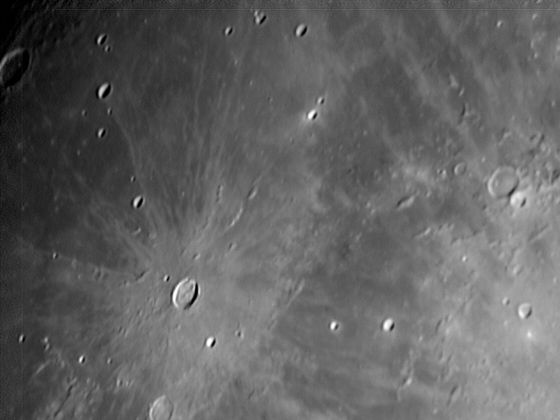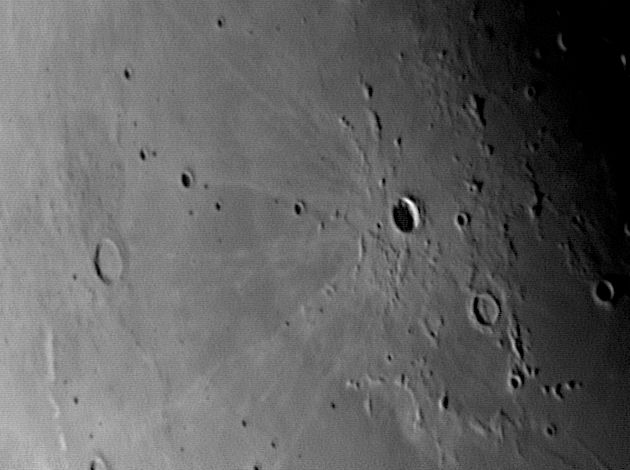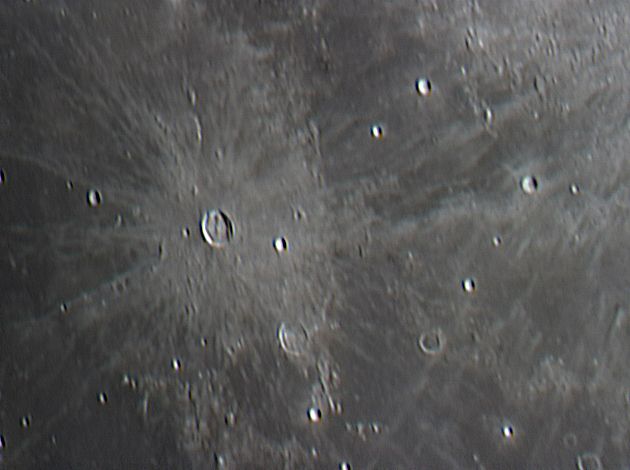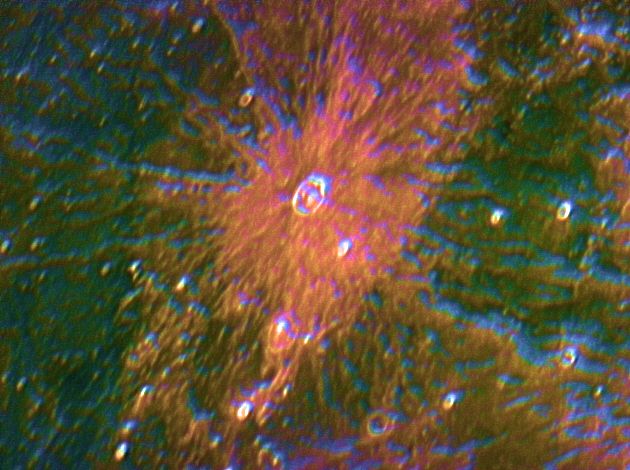Kepler 
Move your mouse over the picture to see the names of the various features. I regret that the scale markers in the first two pictures are not quite right; they should not be quite at right angles. They are more accurate in the third picture.

|
Kepler is an isolated formation about 550 Km south of Aristachus. This picture
almost joins up with my one of Schröter's Valley but I cannot make a
mosaic of the two. Kepler is 32 Km in diameter and 2750 metres deep and is surrounded by the Oceanus Procellarum. It is less than 1,000 million years old. About the
only other feature of note in this picture is Tobias Mayer, 34 Km in diameter and 1600 metres deep, which is a much older feature at around 3,800 million years.
The picture was taken with a ToUcam attached to my LX200 on 25th October 2004 at 22:19 UT when the Moon was 12.6 days old.
The scale markers are approximately 100 Km north and east.
Date and Time: 25th October 2004 22:19 UT
Camera: ToUcam 740K
Telescope: LX200 at prime focus (FL 2500 mm)
Capture: K3CCDTools. High gamma, 1/500", 0% gain, 453 frames
Processing: Registax. 108 frames stacked. Wavelets 1 = 10, 2 = 5 |

|
Another picture covering much the same area but with the light coming from the other direction.
The orientation is rather different (see the scale markers) but covers an area somewhat to the west of the
picture above.
The scale markers are approximately 100 Km north and east.
The picture was taken with a ToUcam attached to my LX200 on 28th September 2005 at 03:31 UT,
when the Moon was 25.1 days old.
Date and Time: 28th September 2005 at 03:31 UT
Camera: ToUcam 740K
Telescope: LX200 with IR-pass filter
Capture: K3CCDTools. Low gamma, 1/25", 66% gain, 311 frames
Processing: Registax. 197 frames stacked. Wavelet 1-2 = 10 |

|
This is a newer picture similar to the one at the top of this page and at the same lunar phase. The ejecta blanket of this relatively young crater is clearly visible in both pictures. The crater is also the centre of a system of rays the beginnings of which can be seen here.
The scale markers are approximately 100 Km north and east (and are a bit better in direction than those in the pictures above, which I may correct some day :-) ).
The picture was taken with a ToUcam attached to my LX200 on 11th May 2006 at 00:13 UT,
when the Moon was 12.5 days old.
Date and Time: 11th May 2006 at 00:13 UT
Camera: ToUcam 740K
Telescope: LX200
Capture: K3CCDTools. Low gamma, 1/50", 16% gain, 454 frames
Processing: Registax. 56 frames stacked. Wavelets 1 = 10, 2 = 5, gamma 1.2 |

|
This picture is shown in exaggerated colour (move your mouse over the picture to see the original). The colour distinguishes well between the ejecta blanket, in pink and orange, and the underlying mare material in green and blue. Kepler is a very recent crater (less than 1,000 million years old) and was formed in the much older mare lava. The projectile cut through the lava and threw out the underlying rock whose composition presumably was similar to the present highland rocks.
Date and Time: 9th October 2006 at 22:25 UT
Camera: ToUcam 740K
Telescope: LX200
Capture: K3CCDTools. Low gamma, 1/250", 20% gain, 456 frames
Processing: Registax. 19 alignment points, 414 frames stacked. Wavelets 1-2 = 10, contrast 130, brightness -28 |
Home Back to NW Quadrant

